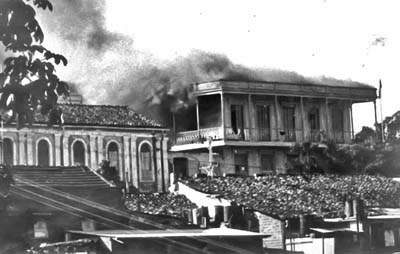On November 30, 1956, in Santiago de Cuba there was an uprising in support of the Landing of the Granma Yacht and today its 65th anniversary is commemorated.
According to the website of the Comptroller General of the Republic of Cuba, on that date the people of Santiago dressed in olive green and went out to defend their rejection of the tyrant Fulgencio Batista in the streets.
Frank País coordinated all the actions to be carried out in the country. According to Lyester Rodríguez´ testimony ?the plan for November 30 was conceived by Fidel Castro in general. Actions had to be carried out in the rest of the Island to prevent Batista´s army from moving its troops quickly enough to the landing area?.
The time chosen to start the actions in Santiago de Cuba was seven in the morning, with the bombardment of the Moncada Barracks by a mortar. Lyester Rodríguez and Josué País were in charge of this operation, but both were arrested before the appointed time and the weapons were left unused at the agreed time.
Since mid-November, Frank had explained to the Movement’s group leaders the objectives of the action in Santiago: to surround the Moncada, to neutralize the troops stationed there and stockpile weapons, for which the Maritime Police, the National Police and an armory in Plaza Dolores.
Tony Alomá had already fallen at another point in the fight, when climbing the last step of Padre Pico. Another group threw Molotov Cocktails at the Station, but they were poorly made and were quickly dying out.
Otto Parellada, even wounded, did not stop shooting until a burst of fire killed him. Far from being daunted, his men intensified the fight. They found a jute sack, put several Molotov cocktails in it, set it on fire and threw it on the ceiling, which began to burn.
Inside the dungeon of the Station were several revolutionaries, previously detained. The policemen left the place and left them at the mercy of the fire, but with a detached brick they broke the padlock on the fence, climbed into some water tanks and jumped to a neighboring house, where the firefighters had already arrived.
The minions of the SIM (Military Intelligence Service) broke into the house, but the owner knew how to hide the escapees very well. The firefighters dressed the revolutionaries in the uniforms of the corps and rescued them one by one.
At the Secondary School, a group of more than 20 young people fought valiantly until the withdrawal order, of them only 12 were members of the July 26 Movement, the others had joined that day.
The general plan contemplated support for the escape of the revolutionaries imprisoned in the Boniato prison, which was finally achieved despite not being able to count on external support, and three of the escapees later reached the rank of commander.
In other parts of the national territory they also fought. In Nicaro, Palma Soriano, Guantánamo, Las Tunas, Baire, Manzanillo, Pinar del Río, fires at service centers in Cienfuegos and Camagüey, occupation of weapons in Santa Clara, sabotage of railways and telephone lines in several Matanzas municipalities. In Havana, a commando set fire to the Almendares and Lugareño mirror factory.
The Landing of the Granma could not take place on the 30th as planned, due to the two-day delay in rescuing a fighter fallen into the sea, and although Fidel’s order was to wait for the landing to trigger the actions, the lack of communication precipitated the events. . The flame of the Revolution was lit.

